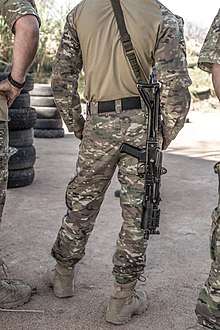Anti-poaching
Anti-poaching is the organised act to counter the poaching of wildlife.[1] However, it is generally used to describe an overall effort against the illegal wildlife trade.[2][3] The act of anti-poaching is normally carried out by national parks on public land and by private security companies on privately owned land. Anti-poaching takes many forms and which depends mainly upon the habitat being protected. Typically, it is the act of actively patrolling land in an effort to prevent poachers from reaching the animals.

Rangers
The most basic level of anti-poaching are the on-site rangers. They are thought of as the first line of defence against the illegal wildlife trade. Rangers typically form squads, usually four men, filling complementary roles. These roles vary depending on the sophistication of the squads. In most situations, rangers are equipped with the bare necessities; a firearm, and a simple uniform.[4] However, in recent times due to the popularity wildlife protection many organisations have been able to obtain the funding to equip their rangers. Hemmersbach Rhino Force is one such organisation to do so, providing each ranger with bulletproof vests, radio handsets, a semi-automatic rifles, night-vision devices and a form of transport.[5]
Rangers perform varied tasks in their daily duties. Patrols make up the majority of a rangers time. Different organisations adopt different strategies to patrols, which is typically based on the animals under their protection. Rangers only protecting a few animals may be tasked with protecting one per squad.[6] This only occurs for large mammals as generally other animals are difficult to track each new day, to make this task easier tracking devices are employed[7]. For smaller animals, or to protect all animals in a given area rangers patrol the boundaries of the areas.
Notable Anti-poaching Organisations
The Kenya Wildlife Service (KWS) is a Kenyan state corporation that was established in 1989 to conserve and manage Kenya’s wildlife. It is established under an Act of Parliament Cap 376 (The Wildlife Conservation and Management (Amendment 1989) Act) with the mandate to conserve and manage wildlife in Kenya, and to enforce related laws and regulations. It manages the biodiversity of the country, protecting and conserving the flora and fauna.[8]
Rhino Force works in South Africa and Zimbabwe to protect all wildlife. They achieve this through a three-pronged approach involving community projects and artificial breeding while the foundation of the organisation relates to anti-poaching. Rhino Force currently has two distinct projects.[9] The Greater Kruger Project involves protecting privately owned black and white rhinoceros. Their second project aims to secure the Zambezi Valley from poaching in order to reintroduce black rhinoceros.[10]
The Sea Shepherd Conservation Society is an international marine protection organisation, which is particularly committed to protecting the sea, combating illegal fishing, killing marine mammals, turtles and sharks, and reducing sea pollution.[11]
References
- "What is a Ranger?". WWF. Retrieved 16 January 2020.
- "Illegal Wildlife Trade". WWF. WWF. Retrieved 16 January 2020.
- NEME, LAUREL. "For Rangers on the Front Lines of Anti-Poaching Wars, Daily Trauma". National Geographic. National Geographic.
- Junker, J. "Action: Provide better equipment (e.g. guns) to anti-poaching ranger patrols". Conservation Evidence. hat Works in Conservation.
- "Hemmersbach Rhino Force". Hemmersbach Rhino Force. Hemmersbach Rhino Force.
- "Meet the Heroes Who Protect the Last Northern White Rhinos in the World". National Geographic. Retrieved 16 January 2020.
- "Elephant Tracking Collars". ElephanTTrackinG. Retrieved 16 January 2020.
- "Kenya Wildlife Service". Archived from the original on 2011-10-31. Retrieved 2019-10-11.
- Rhino Force projects
- Hemmersbach Rhino Force
- Sea Shepherd